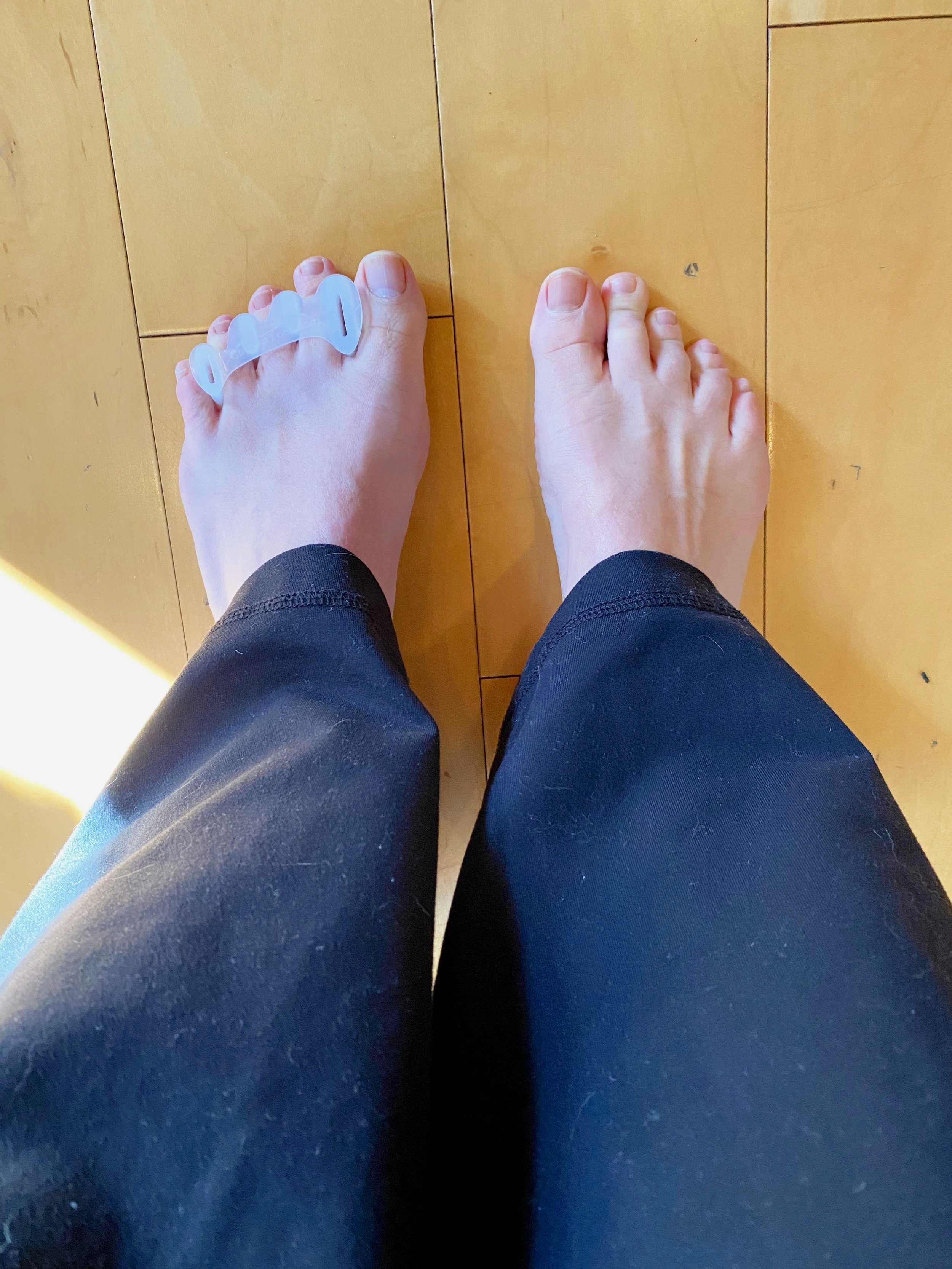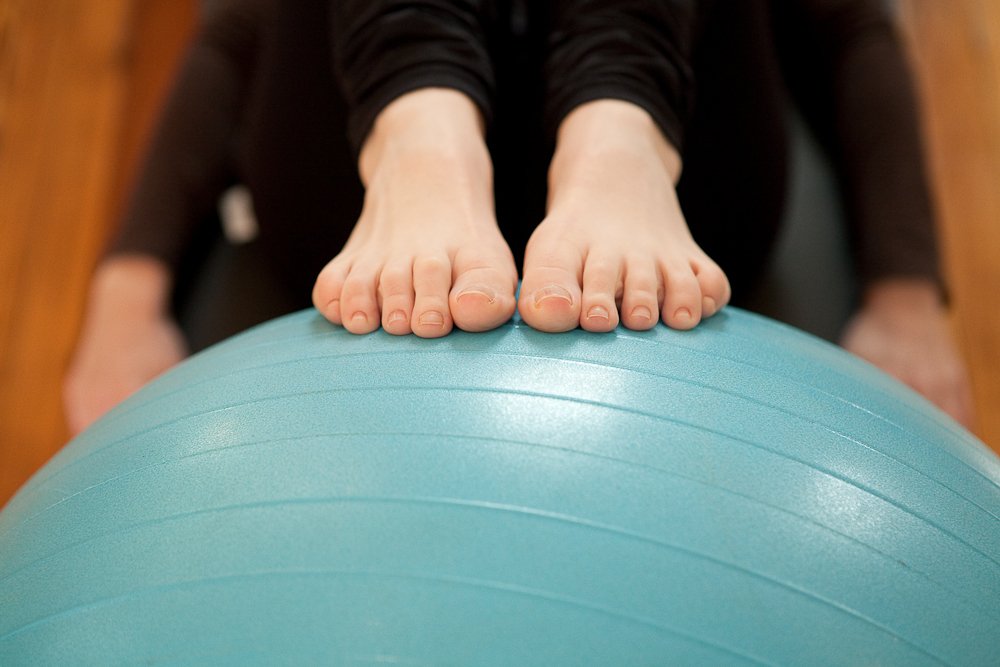The Importance of Foot Stability and Mobility + Exercises for Happy Feet
Roll It Out
Use a tennis ball or firm myofascial ball to mobilize and strengthen the foot.
If you’ve been in our Pilates studio, you know that footwork is integral to the practice and this is by design. Foot mobility and stability significantly affect walking, running and load bearing movements as the feet are the primary point of contact with the ground during these activities.
Ideally, feet should possess a balance of strength and mobility. Both attributes are essential for optimal foot function and overall lower limb biomechanics.
Having excessively strong but immobile feet or excessively mobile but weak feet can lead to biomechanics issues and increased injury risk. It's important to strike a balance between foot strength and mobility through targeted exercises and activities that promote both aspects of foot health.
Pilates footwork increases the strength and mobility of the feet. Seen here is “Walking” on the Pilates Reformer.
Strength: Strong feet provide a stable foundation for the body. Foot strength helps support the arches, maintain proper alignment of the bones and joints, and resist excessive pronation or supination. Strong foot muscles also contribute to push-off power during propulsion, improving speed and efficiency of movement.
Mobility: Adequate foot mobility allows for natural movement patterns and shock absorption. Mobility enables the foot to adapt to various surfaces, absorb impact forces, and distribute weight evenly across the foot. Proper foot mobility also helps prevent stiffness and rigidity, reducing the risk of overuse injuries and improving overall flexibility and range of motion.
Want to know a little bit more about what the foot does to affect efficiency of movement, especially with running, walking or load bearing activities? Here are a few examples:
Carla Shifflett discussing the importance of “toe-off” in our online videos.
Propulsion: Foot mobility plays a crucial role in the propulsion phase of walking and running. The ability to dorsiflex, plantarflex, and toe-off efficiently contribute to forward propulsion and energy transfer during each step. This allows for a more powerful push-off and improved speed and efficiency of movement.
Shock Absorption: Strong, pliable feet play a crucial role in shock absorption. They help dissipate impact forces generated during walking and running and allow the foot to adapt to uneven terrain. The foot's ability to pronate and supinate helps distribute impact forces evenly, reducing the strain on joints and soft tissues throughout the lower extremities.
Stability and Balance: While foot mobility is important, so is stability. Optimal foot stability ensures that the foot maintains a solid base of support during ground contact, enhancing balance and stability. Stable feet help prevent excessive pronation or supination, reducing the risk of ankle sprains and other injuries. Instability in the feet can affect proprioception and neuromuscular control, increasing the risk of falls on uneven terrain or during rapid changes in direction.
Prevention of Overuse Injuries: Proper foot mobility and stability help distribute forces evenly throughout the foot and lower extremities, reducing the risk of overuse injuries such as plantar fasciitis, Achilles tendinitis, shin splints, and stress fractures.
Other considerations for foot health include:
Wear appropriate footwear that provides adequate support, cushioning, and stability. Ill-fitting or unsupportive shoes can exacerbate existing foot issues, contribute to the development of new problems, and hinder optimal biomechanics during walking and running.
Correct Toes are spacers for toes that have lost width due to biomechanics or improper shoe width. Notice the foot on the right has tension and the toes are gripping for support. Toe spacers can help. Check them out in the studio.
Listen to your feet! Any foot pain or discomfort, whether caused by structural issues, overuse injuries, or improper footwear, can significantly impact walking and running. Painful conditions like bunions, corns, calluses, or blisters can affect gait mechanics, decrease stride length, and alter foot strike patterns, leading to compensatory movements and decreased performance. If your feet hurt, address the issues causing the pain.
Take care of your feet. They are one of the most overlooked parts of our health regimen, yet are literally our main point of contact for functional movements.
Pilates exercises are performed in bare feet in order to build foot strength and proprioception.
Strength Exercises: Toe curls, towel scrunches, marble pickups, and resistance band exercises can help strengthen the muscles of the feet and ankles.
Mobility Exercises: Ankle circles, toe stretches, calf stretches, and using mobility tools like foam rollers or massage balls can improve foot flexibility and range of motion.
Functional Movements: Engaging in activities like barefoot walking, balancing exercises, and yoga that incorporate both strength and mobility components can help maintain balanced foot function.
Ready to try it? Grab a myofascial release ball, such as a lacrosse ball or a specialized foot massage ball (like the ones we have in the studio).
Tara Fontenot discussing foot health on our Virtual Videos.
Plantar Fascia Roll:
Sit on a chair or on the floor with your feet flat.
Place the myofascial release ball under one foot, targeting the arch.
Apply gentle pressure and roll the ball from the heel to the ball of the foot, focusing on areas of tension.
Spend extra time on any tender spots.
Repeat on the other foot.
Arch Roll:
Sit on a chair or on the floor with your feet flat.
Place the myofascial release ball under one foot, targeting the arch.
Apply pressure and roll the ball back and forth along the arch, from the heel to the ball of the foot.
Roll for 1-2 minutes, then switch to the other foot.
Toe Roll:
Sit on a chair or on the floor with your feet flat.
Place the myofascial release ball under one foot, targeting the area beneath the toes.
Apply pressure and roll the ball back and forth beneath the toes.
Roll for 1-2 minutes, then switch to the other foot.
Toe Stretch:
Sit on a chair and place the myofascial release ball under one foot, near the base of the toes.
Curl your toes over the ball and gently press down to stretch the toes and the underside of the foot.
Hold for 10-15 seconds, then release.
Repeat 2-3 times, then switch to the other foot.
Foot Massage:
Sit on a chair or on the floor with your feet flat.
Place the myofascial release ball under one foot and apply pressure as desired.
Use small circular motions to massage the entire surface of the foot, including the arch, heel, and ball of the foot.
Spend extra time on areas of tension or discomfort.
Repeat on the other foot.
Toe Stretch and Spread:
Sit on a chair and place the myofascial release ball under one foot, near the base of the toes.
Gently press down on the ball to stretch the toes, then spread the toes apart as much as possible.
Hold for 10-15 seconds, then release.
Repeat 2-3 times, then switch to the other foot.
Performing these exercises regularly can help improve foot mobility, reduce muscle tension, and alleviate discomfort. Start with gentle pressure and gradually increase as tolerated. If you experience any pain or discomfort beyond a tolerable level, stop the exercise and consult with a healthcare professional.








